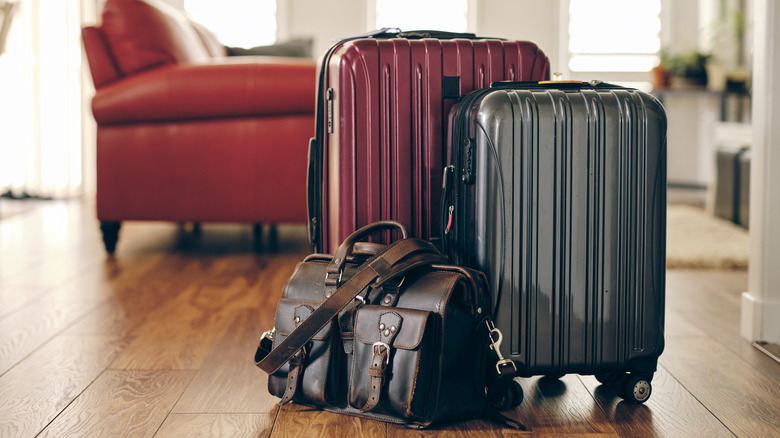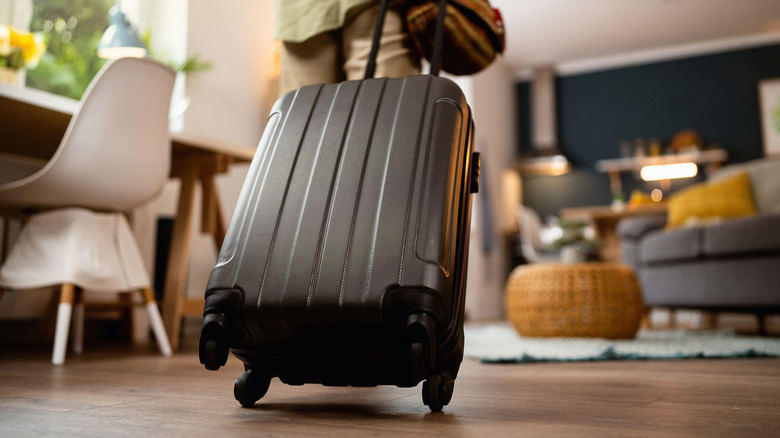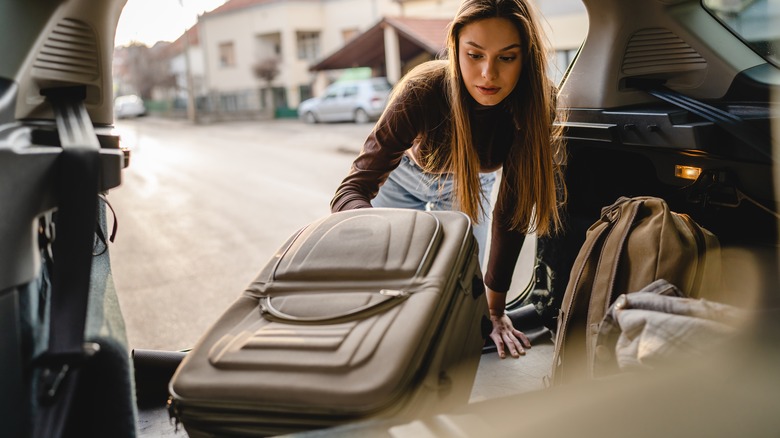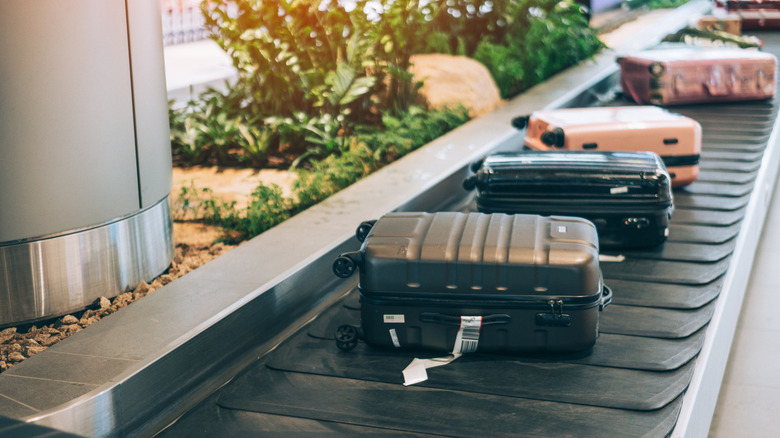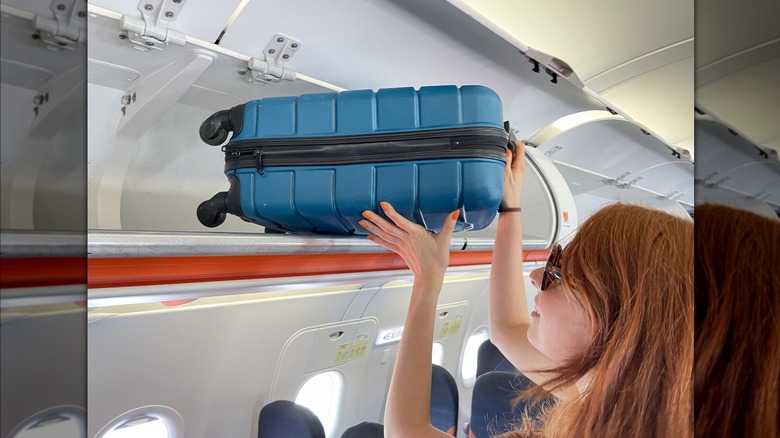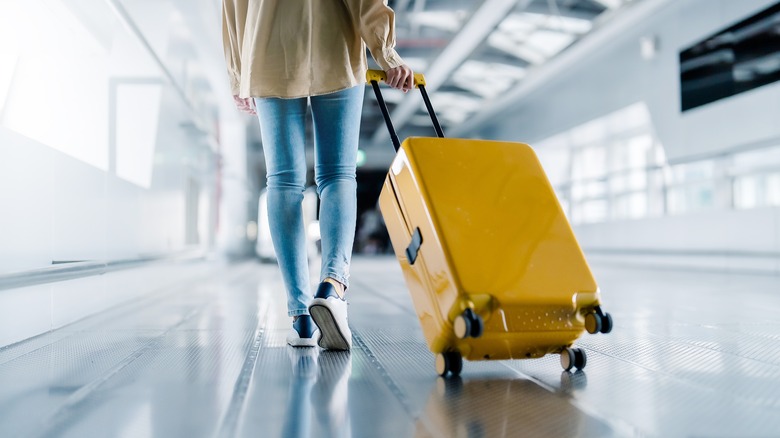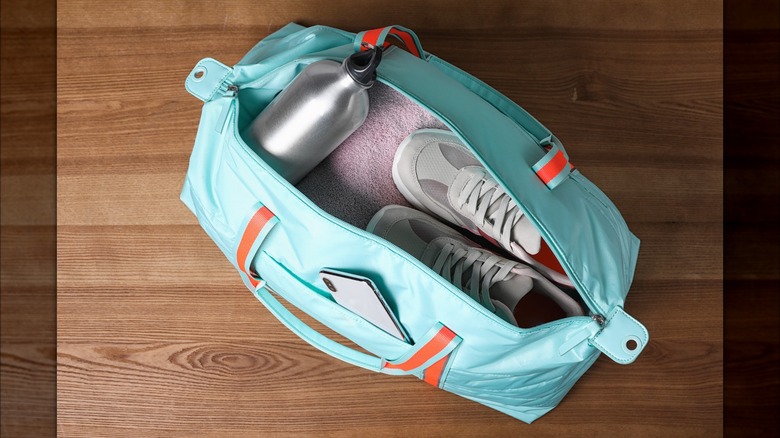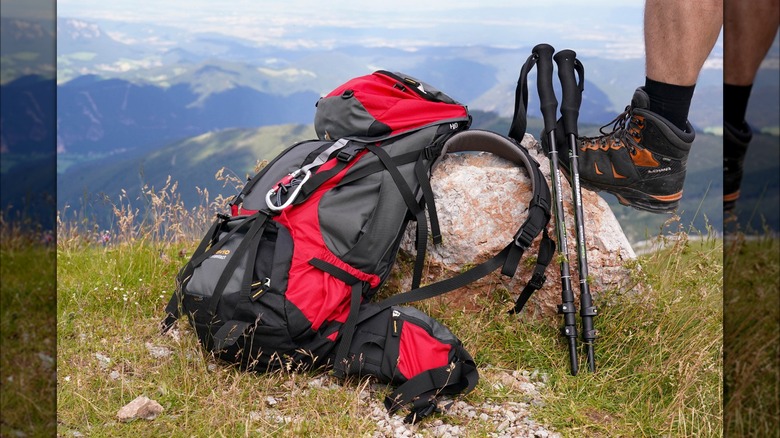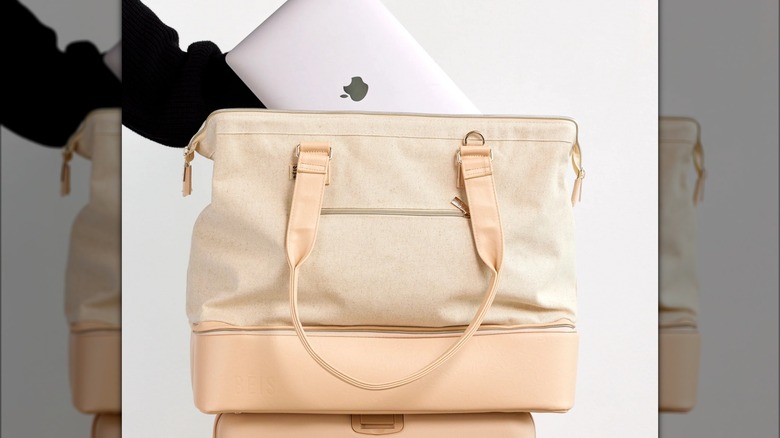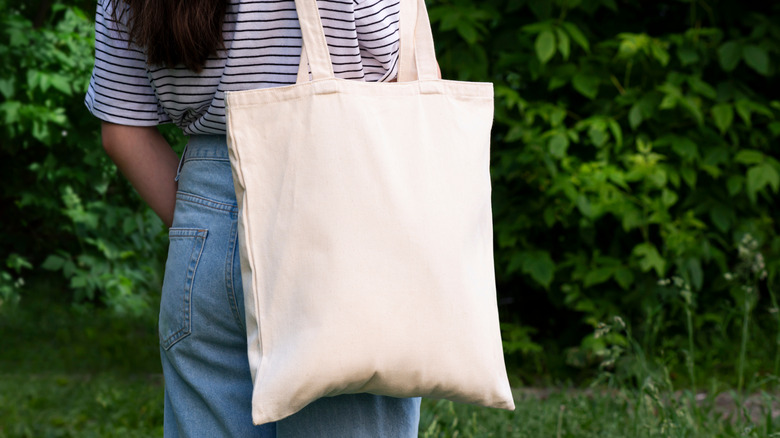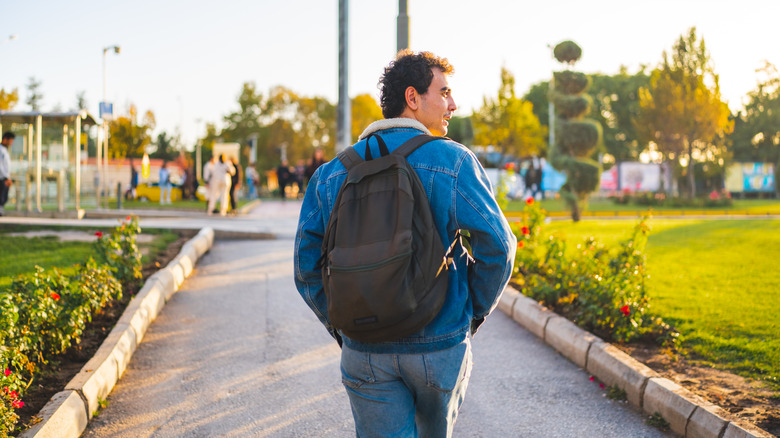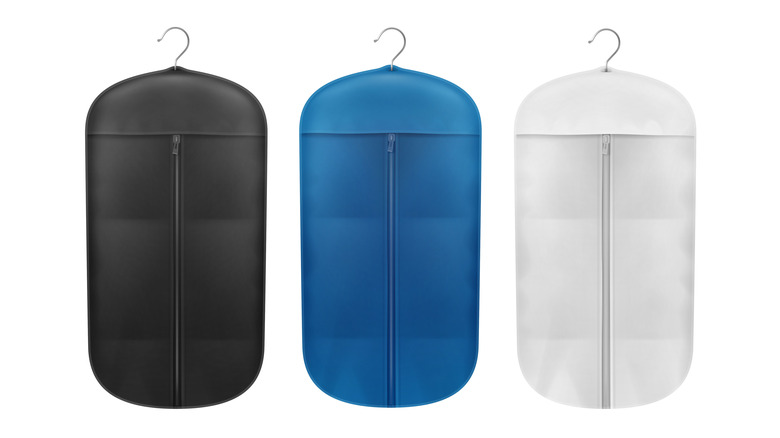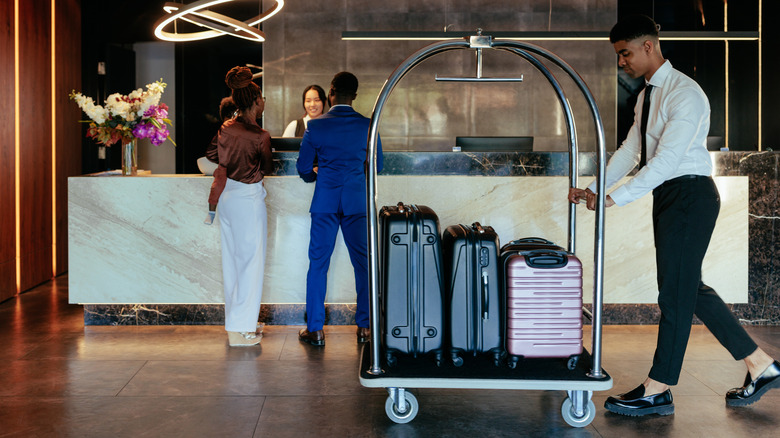The Hidden Risks Of These Common Types Of Luggage
Planning an upcoming trip? Packing is one of the most important parts of prepping — and it's not just what goes inside your bag that matters. The type of luggage you use greatly impacts your experience, and picking the right bag for your travels is crucial.
You may have considered your ideal baggage based on size and aesthetics, but chances are, you've overlooked some hidden risks — and we can't blame you. If you're excited to travel, you probably want to toss your stuff in a suitcase and hit the road. But before you pack, we'd carefully consider the type of luggage you choose. If not, that decision can come back to haunt you. That large rolling suitcase might seem like a great idea at the airport, but not so much on a cross-country trek. Meanwhile, a suede tote bag may win some fashion points, but it wouldn't fare too well in a rainstorm.
Ultimately, all types of luggage have pros and cons, along with some hidden risks. Manufacturers don't exactly advertise these issues, which can include concerns with security, durability, and functionality. But if you're still not sure what to look out for, don't worry. We're here to burst this suitcase of secrets wide open. Before you pack those bags, read on for the hidden risks of these common types of luggage.
Hardside suitcase
Hardside luggage provides a sense of security, and you feel like your belongings are well-protected from the elements, but this durability comes with a price. For one, hard suitcases can't compress into tighter spaces. It either fits or doesn't, and you may find yourself playing some trunk Tetris to fit all the bags in. Secondly, hardshell suitcases often scratch easily, especially light-colored ones. There are always some clever hacks to remove the scuff marks, but that can become a hassle if you travel frequently.
These suitcases also have some accessibility issues. No outside pockets mean you don't have a convenient area to store and retrieve important items like travel documents, a book, or a sweater. Plus, the zippers tend to be in the middle of hard-shelled luggage. If you don't open the bag correctly or the contents shuffle during transit, things can spill out easily.
Nowadays, hardside luggage usually comes with a thin shell, meaning you can fit a significant amount inside — perhaps too much. And when packed to the brim with clothing and necessities, you might exceed airline weight limits. We'd err on the side of caution and weigh your baggage in advance. If you don't have a handy luggage scale, pack your belongings loosely, and don't forget to save room for souvenirs.
Softside suitcase
Compared to hardside suitcases, softside luggage does have some serious pros. It's more malleable and well-suited to that optimistic traveler who wants to squeeze just one more item inside. And with multiple compartments, you've got easy access to your essentials. However, the fabric's flexibility may also be its downfall. Since there is more give to the material, there's also less protection. Baggage handlers might toss heavier bags on your suitcase, and if you've got fragile items or electronics inside, let's hope they can withstand the pressure.
If the suitcase isn't made with a durable fabric, you might be in for troublesome travels. Unless they're weatherproof and stainproof, softside suitcases might get damaged if wet. Think a torrential downpour en route to your hotel — or a glass of spilled wine at the airport bar. And if that fabric tears, you better hope you've got some duct tape on hand before departure. Mind you, with a good quality fabric, you should be covered, but these hidden risks are something to keep in mind when deciding between softside or hardside baggage.
Checked luggage
To check luggage or not to check luggage? This remains a hotly debated topic, dividing travel companions and stressing out even the strongest couples. It's almost as telling as whether you're an aisle or a window person. If you're not a fan of checking bags when flying, we've got ammunition for your argument. Checked luggage allowances might mean you can travel with larger bags and more weight, but this benefit can come at a hefty price. According to CNBC, American Airlines, Alaska Air, and JetBlue have increased their checked luggage fees as of 2024. With inflation and the rising cost of air travel, we wouldn't be surprised if other airlines followed suit.
Larger bags translate to more wardrobe options, which can be a blessing if packing for winter weather. That being said, you'll have to lug around that extra weight en route, not to mention deal with baggage claim. This is time-consuming at best, but if the airline loses your precious cargo, it can turn into quite a catastrophe. Depending on how quickly the airline can return your possessions, you might end up spending the first half of your vacation shopping for essentials or washing the same outfit in the hotel sink.
Carry-on luggage
No need to wait for baggage claim or worry about lost luggage, as you can walk straight out of the airport with a carry-on. While this might seem ideal, the risks of carry-on baggage are more subtle. If you've ever seen people lining up to get on the plane first, the reason might be their bags. Overhead bin space is limited, and it's a first come, first serve scenario on planes. So, although carry-on luggage eases stress in other ways, it activates that survival of the fittest response and often brings out the worst in people. Don't expect to fully relax until your bags are safely stored in the overhead compartment.
Another risk with carry-on baggage is an airline's size and weight limitations. Most major airlines allow bags within 14" x 22" x 9", including wheels. While some domestic airlines have no formal weight restrictions, budget carriers like RyanAir will charge you for a carry-on bag with a maximum weight of 22 pounds. This might be enough for a week or so, but it gets tricky on longer trips. Say goodbye to any non-essential items, not to mention regular-sized toiletries.
Dual-spinner suitcases
People have been rolling their suitcases through airports for decades, and their backs could not be happier. The first rolling suitcase hit the travel scene in the 1970s; it lay horizontal and was pulled by a strap, but over time, the norm became vertically-wheeled bags with two wheels and retractable handles. In 2004, Samsonite rolled out the dual-spinner suitcase, the first of its kind. These dual-spinner bags have four wheels and can move in any direction. They don't need to be pulled; they simply glide, which can, quite literally, be their biggest downfall.
Spinner luggage works exceptionally well on flat surfaces. However, it doesn't fare well on cobblestone streets or rugged terrain. Imagine climbing a steep incline to get to your Italian villa. You'll want to keep a firm grasp on that luggage so it doesn't take off down the hillside. Even if you don't experience runaway luggage, you better hope those wheels are of the utmost quality. When just one wheel gets worn or breaks off, it can render the rest useless.
Dual-spinning wheels are also typically built on the outside of the suitcase, adding to the overall height. If you're using a carry-on, the wheels might put you over the limit because many airlines require bags to fit vertically in the overhead compartment. While we've all seen that person taking up extra space horizontally, it's definitely a faux pas as far as flight attendants are concerned.
Duffel bag
Duffel bags are the luggage of choice for many sports enthusiasts, with a no-frills design that's spacious and easy to pack. You can toss belongings in or stash bulky sports gear, but with such an open design, organization is tricky. A trip to the gym is one thing, but longer vacations may have you rummaging through your bag and discovering wrinkled shirts. Of course, you can always stock up on inexpensive, helpful packing items like packing cubes and plastic baggies, but prices add up, and it's less convenient than having built-in luggage compartments. Regardless, items will likely get jostled around in transit, so you better hope that shampoo is well-sealed.
Size and security are also issues. A small duffel bag with a strap is easy to carry, but an oversized sports duffel can feel awkward and cause shoulder strains. If this is the case, make sure the bag has wheels and a handle for easy rolling. If you're concerned about theft, invest in a duffel bag with anti-rip material and buy a safety lock. After all, this style of luggage rarely comes with any security features.
Hiking backpack
Hiking packs are built for long treks and backpacking trips, and whether wading through water or running to catch that bus, you can rely on this durable design. But if you plan to check it on an upcoming flight, be extra cautious. These packs come with straps, belts, buckles, and zippers that can get caught in airline machinery, like conveyor belts. It sounds far-fetched, but it happens more often than you realize, and the outcome can cause serious setbacks.
One previous traveler we spoke to couldn't find her pack on the luggage carousel. After waiting ages, she recognized some of her belongings circling in a giant plastic bag. Upon closer inspection, the plastic bag contained her hiking pack along with her possessions, which all appeared semi-shredded. Airport personnel explained that a loose strap got caught in the conveyor belt, and by the time they could pull it out and place it in a secure bag, it was too little too late.
To avoid a similar catastrophe, tighten and tie all loose straps and belts. The tidier your bag, the less risky it'll be. If you're still worried, ask check-in staff if they can place it in a plastic bag. Not only will this ensure your bag is safe in transit, but it'll protect it from rain or snow. If all else fails, you can always get your luggage plastic-wrapped at the airport.
Weekender bag
Weekender bags might be stylish, but they have limited space. After all, they don't call them "weekender bags" for nothing. So, if you're heading out for more than just a few days, you'll have to exercise some serious minimalism.
Size aside, the biggest hidden risk of weekender bags is muscle strain. These bags come with handles, some long enough to carry over one shoulder, which creates posture issues. In an interview with Time Magazine, orthopedic surgeon Sabrina Strickland explains, "When you carry a heavy bag on your shoulder, you kind of have to lift [your shoulder] or lean over to the other side, otherwise it's going to fall right off. However long you're holding that bag, you're holding your spine in a curved way."
If you're going to have a sore neck after traveling, let it be from all those adventure sports or shopping you'll be doing. Instead, pack your weekender bag extra light and bring an extra suitcase. Well-designed weekender bags often come with a luggage strap, so if you can slide it over your carry-on, your body will thank you.
Tote bag
Tote bags are having a moment. They offer a practical way to carry your belongings around town, as well as a means to express your personality. From designer totes to DIY canvas ones, you've got options. And if you want to support a local brand, sling one of their totes over your shoulder. But be aware, if you pack too much, totes run the same risk of straining your shoulder as weekender bags would.
To make matters worse, totes typically have an open-bag design, making them more accessible to pickpocketers. Totes are quite deep, so if you're carrying your bag close to your body, the lack of security might not be an issue. However, we wouldn't set a tote bag down in cities or places known for opportunistic theft. Even if pickpockets don't target you, things can easily spill out when you set the bag down. As such, totes make a great shopping bag on your travels, but we'd avoid carrying anything too valuable inside.
Standard backpack
Standard backpacks never go out of style. Their design is super functional, and the size means you can even squeeze it under airplane seats, meaning a backpack can count as a personal item rather than a carry-on when flying. However, you'll probably need a separate carry-on, seeing as a medium backpack only fits around 30 liters. And as ergonomic as they might seem, backpacks weigh on you over time.
In a Reader's Digest interview, board-certified physical medicine and rehabilitation physician D'Wan Carpenter explains, "In the long term, wearing a heavy backpack every day can cause misalignment of the spine and acceleration of the degenerative process of normal aging of the spine. The muscles can become subject to overuse, which can, in turn, become more subjected to injury." This disproportionate weight is the sort of thing that creeps up on you. Backpacks may feel fine initially, but you can start to notice some aches and pains after a few weeks of consistent use. Of course, it all depends on how heavy your luggage is and how often you carry it. But, if you can, we'd opt for one with wheels or load lifters and waist straps to support better posture.
Garment bag
Are you traveling with a three-piece suit or a wedding gown? If so, you may have packed these dressier items in a garment bag for safekeeping. But how safe are they really? If you can keep them with your person, chances are they'll be absolutely fine. However, if you plan to fly, know that many airlines count a garment bag as your carry-on item. American Airlines is just one company that considers garment bags a carry-on and limits them to 51 inches (length + width + height). You'll need to place it in the overhead bin, and if people rearrange items or try to stuff that extra bag in, your garments could end up getting crushed. Similarly, if checked, they can end up folded or placed under heavy items, wrinkling and damaging the clothing you're trying to protect.
One way to avoid the hidden risks of traveling with a garment bag is to pack it in a suitcase. Make sure the bag is zippered, secured, and folded gently to prevent creases. And if that's still too risky, shop for a garment bag designed as a carry-on for extra protection.
Neutral-colored luggage
We've covered the hidden dangers of different types of luggage, but we're not done just yet. We have one more item, and it might come as a surprise, so here it goes: Did you know the color of your baggage can pose a risk as well? Yep, the color of your bag can actually increase your odds of being robbed.
Bob Arno, a travel author specializing in theft and pickpocketing, reports that most stolen luggage is black. Since it's such a popular color, he explains, "If the thief is caught red-handed by the bag's owner, he only has to say 'Sorry, it looks just like mine.' And he's out of there. Scot-free." Baggage can be snatched while waiting around at airports or even from bag carousels — after all, you don't have to go through security to access domestic luggage carousels in the States. But airports aren't the only place thieves can strike. The same can happen in any busy area with tourists, like hotel lobbies or bus and train stations.
Any easy fix? Buy colorful luggage to stand out from the pack. Black, along with neutral colors, are the most popular options for baggage, but a thief is going to think twice before snatching that Barbie pink suitcase. And if you aren't quite ready to commit to a colorful case, a crazy slipcover or beautiful bow should do the trick.
